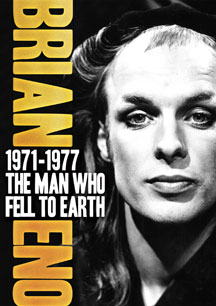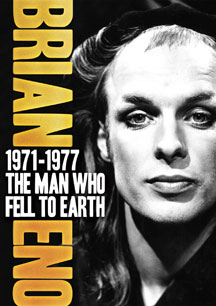
Brian Eno: The Man Who Fell to Earth, 1971-1977
Sexy Intellectual

For all of his achievements – and they are truly vast – it’s a wonder no one has seen fit to attempt to tell the story of Brian Eno, one of the true innovators and shapers of modern music, culture, and art, prior to now. And while this documentary features no new interviews with Eno, nor is it authorized by him, it tells a fascinating tale of the non-musician, and how his restless imagination and unconventional work habits propelled him to tie his various influences from art school to ’50s rock and groundbreaking new avenues of sound.
Eno’s start came about from his fascination with the technical aspects of music – tape machines, feedback loops, and sound modification devices – originally off-stage with Roxy Music. Soon he was manipulating their live sound and playing synth, beginning to develop his unique sonic signature of loops and sound tweaks on the group’s first two albums. Once he departed the group, he found himself regaled as something he really wasn’t: a musician. And while he had no training nor real technique musically, it soon became evident that his true gifts were his ability to experiment and to discard conventional wisdom and cliché in an effort to satisfy his relentless workaholic nature. This film focuses on the years 1971-1977, during which he released four solo vocal albums: 1973’s Here Come the Warm Jets, followed in 1974 with Taking Tiger Mountain by Strategy, the landmark Another Green World in 1975, and finally, Before and After Science in 1977. In-between these, he brought mainstream attention to ambient music with Discreet Music, recorded several albums with the German group Cluster, and started the Obscure label which released decidedly non-mainstream acts such as Harold Budd and Michael Nyman. Add to this his production and performing on such albums as David Bowie’s Low and Heroes, Devo’s debut, and works from John Cale, and a picture emerges of a man whose influence literally reshaped the way we hear music.
He did all this not by following conventional methods of musical achievement, the decades of rigorous practice and adoption of typical forms, but rather by challenging the creative process itself. A prime example was his invention, along with artist Peter Schmidt, of the Oblique Strategies, a system of simple phrases on cards, meant to spur the reader into alternate paths of creation, such as “What to increase? What to reduce?” or “Try faking it!” It is in this sort of thinking that we see the true genius that is Eno, an artist unrestrained by the commonly held notions of the possible, unburdened by years of training, using a nimble and curious mind to expand upon chance events that life hands you, and develop that into a fully realized idea. It is from such an event, being bedridden in the hospital while a record of harp music played at barely audible levels across the room, that he was led to investigate moving music from the foreground to the background, i.e., ambient music.
As this fascinating glimpse shows us, Brian Eno is truly a revolutionary artist both of sound and the creative process itself, and his fingerprints can be found in nearly all aspects of what we call music today. Highly recommended.
See of Sound: [www.seeofsound.com](http://www.seeofsound.com/p.php?s=SIDVD564)












